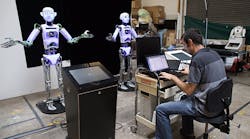Improving Manufacturing Education and Innovation
The United States has long led the world in science-based innovation—as over the past half century research from U.S. academic, corporate, and government laboratories contributed to a series of breakthrough technological innovations in everything from transistors and mobile phones, to lasers, graphical user interfaces, the Internet, genetic sequencing, and biologic drugs.
That approach worked well when few nations had the capacity to leverage U.S. scientific discoveries for their competitive advantage.
But today, U.S. federal R&D dollars for basic science generate knowledge that is essentially a non-rival, non-appropriable public good that can be quickly picked up and leveraged by foreign competitors, who often rely on the basic research discoveries coming out of U.S. universities and national laboratories, allowing them to concentrate their efforts on turning U.S. scientific discoveries into their own innovative products which they manufacture and sell to other nations.
That’s why science-based discoveries aren’t sufficient anymore; the United States must also be able to make things here. And that requires engineering-based innovation, an appropriable activity through which U.S. establishments can add and capture value. And this requires America getting better at generating pathways that turn science into U.S.-made high-technology products.
And two key, complementary approaches to addressing that challenge are creating American Manufacturing Universities and establishing Institutes of Manufacturing Innovation that become part of a National Network for Manufacturing Innovation (or NNMI).
Regarding the first, Senators Chris Coons (D-DE) and Lindsay Graham (R-SC) alongside Representatives Elizabeth Esty (D-CT) and Chris Collins (R-NY) have proposed bipartisan, bicameral legislation in the Manufacturing Universities Act of 2014 that would incentivize post-secondary engineering programs at 25 American “Manufacturing Universities” to focus more on advanced manufacturing and producing graduates better equipped with the knowledge and skills needed for careers in emerging, innovation-based advanced manufacturing industries.
The legislation calls for designated schools to receive $5 million per year for four years to revamp their engineering programs to focus on manufacturing engineering, to build new partnerships with manufacturing enterprises, to increase training opportunities, and to foster manufacturing entrepreneurship in a program run by the U.S. National Institute of Standards and Technology (NIST).
Collaborative Education
The Manufacturing Universities would emphasize joint industry-university research projects, training of students that incorporates manufacturing experiences through co-ops and internships, and a focus on turning out more Ph.D. engineering grads who work in industry.
As Karen Fletcher, Chief Engineer at Dupont Corporation, explains, “The Manufacturing Universities Act of 2014 will strengthen the pipeline of talented men and women whom DuPont relies on and represents an important step in promoting R&D and innovation, thereby keeping American manufacturing competitive in the global economy.”
America’s Manufacturing Universities would complement another institutional approach being stood up to revitalize American manufacturing competiveness: the National Network for Manufacturing Innovation, composed of individual Institutes for Manufacturing Innovation (IMIs), public-private partnerships between the federal government and its mission-oriented agencies, local governments, universities, research institutes, industry, and small businesses designed to accelerate innovation in advanced manufacturing product and process technologies.
The IMIs seek to create an effective manufacturing research infrastructure for U.S. industry and academia to solve industry-relevant problems; create, showcase, and deploy new capabilities, products, and processes that can impact commercial production; and build workforce skills at all levels.
Four IMIs have already been established—focused on additive manufacturing, next-generation power electronics, lightweight composites and materials, and digital manufacturing and design innovation—with four more are currently being tendered.
Further, the bipartisan Revitalize American Manufacturing Innovation Act of 2014 (RAMI) authored by Senators Sherrod Brown (D-OH) and Roy Blunt (R-MO) and Representatives Tom Reed (R-NY) and Patrick Kennedy (D-RI) would authorize the U.S. Department of Commerce to invest $300 million in one-time funding to catalyze at least four additional industry-led IMIs.
Industry has matched federal investment in the IMIs on at least a dollar-for-dollar basis, and in the case of the most recent IMI, the Digital Manufacturing and Design Innovation Institute in Chicago, industry matched the government’s $70 million investment with $210 million of its own, a 3 to 1 return on federal dollars.
Recognizing that the National Network for Manufacturing Innovation is supported by a broad collation of stakeholders—including industry, universities, associations, labor representatives, and mission-oriented agencies such as the Department of Energy and Department of Defense (which recognizes the Institutes’ unique role in maintaining the strength of America’s defense industrial base)—the U.S. House of Representatives passed the RAMI legislation on September 15, 2014 and it is hoped the Senate will take up this important legislation when it returns after the November elections.
While some have expressed concern that the Manufacturing Universities and the Institutes for Manufacturing Innovation may be redundant, the reality is that they are complements to, not substitutes for, one another.
First, the 25 Manufacturing Universities would broadly align engineering educational offerings with the needs of modern manufacturers across a broad and wide range of manufacturing industries. Not only will this produce specialized engineering talent that help America’s manufacturers innovate the next-generation products of tomorrow, they will also play an important role in equipping undergraduates and graduate students with in-demand engineering skills, helping to address the reality that thousands of American manufacturing jobs go unfulfilled annually because of mismatched skills.
In contrast, at least for the foreseeable future, America won’t have more than ten to fifteen IMIs—each focused on a rather specific advanced manufacturing product or process technology—so the IMIs’ focus will be narrower and the manufacturing universities’ broader.
Moreover, the Manufacturing Universities will represent feeders of talented students who can work on collaborative industry-university research projects and toward solving specific industrial engineering challenges, occasionally leveraging the shared physical facilities and equipment at the various Institutes of Manufacturing Innovation, which will effectively provide a test-bed for experimentation with advanced manufacturing processes and techniques.
At the same time, it’s important to remember that, while the IMIs will represent national resources with regard to the manufacturing technologies and processes they focus on—that is, all American manufacturers will be positioned to benefit from discoveries made by the 94-member America Makes consortium focused on additive (or 3-D) printing in Youngstown, Ohio—the Institutes’ impact will be felt most strongly regionally, by local enterprises and universities who participate in the consortium and whose students can leverage the shared resources, equipment, and test-bed facilities located at the Youngstown, Ohio facility as they work on collaborative research projects with industry.
To be sure, the IMIs will play an important role in developing educational and training curriculum and contributing to broad industrial workforce training in the advanced manufacturing product and process technologies they focus on, but once again this will be focused toward specific manufacturing products and process technologies. So the IMIs will be national assets, but with a strong regional footprint, while the 25 Manufacturing Universities will have a broader remit, training engineers across a broader range of advanced manufacturing technologies and sectors.
Moreover, the Manufacturing Universities will be consumers of the new knowledge about advanced manufacturing processes pioneered at the Institutes and be positioned to disseminate that knowledge to their students, and thus play an important knowledge intermediary dissemination role.
In summary, America’s Manufacturing Universities and Institutes of Manufacturing Innovation should be seen as vital assets operating hand-in-hand toward American manufacturing renewal.




